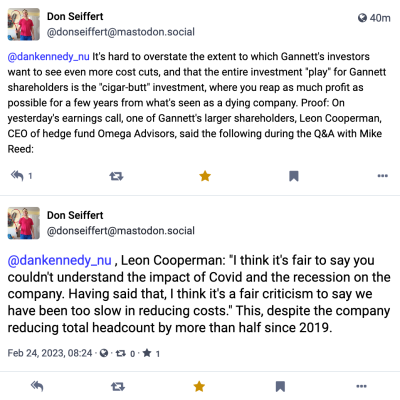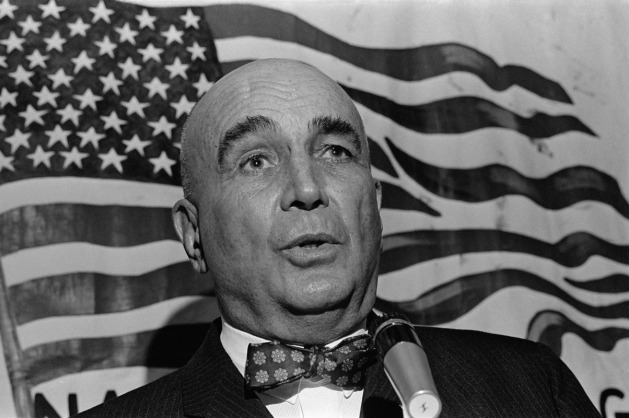
Michael Anastasi. Photo via LinkedIn.
As you may have heard, union journalists at many Gannett newspapers staged a one-day strike Monday to protest chair Michael Reed’s brutal leadership style, which has resulted in devastating cuts and a sliding stock price even as he’s pulled down more than $11 million in compensation over the past two years.
I’ll get back to that. But first I want to discuss a less publicized development. Over the past several weeks, Gannett has made a couple of personnel moves aimed at — wait for it — reinvigorating local coverage at the country’s largest newspaper chain.
On May 19 came word that Michael Anastasi, vice president of The Tennessean of Nashville and editor of USA Today’s South Region, was being promoted to the newly created position of vice president of local, part of what the company is calling “a new nationwide Gannett effort to transform the growth trajectory for hundreds of local newspapers.”
In an article announcing the move, Anastasi was quoted as saying, “I can’t wait to help accelerate our transformation as I work with the thousands of local Gannett journalists across the country.” He’ll report to Kristin Roberts, Gannett’s chief content officer, who stated, “We are going to save local journalism, and we’re going to do it by working together with absolutely clear eyes about the challenge and tremendous speed toward the solution.”
Anastasi’s promotion is part of what Gannett is calling Project Breakthrough, which “focuses on key growth areas to increase nationwide audience, including opinion columns, newsletters, service journalism, breaking news and audience engagement.”

Imtiaz Patel. Photo via LinkedIn.
Less than two weeks later came word that Imtiaz Patel, chief executive officer of The Baltimore Banner, will leave July 7 in order to become a top executive at Gannett. According to the Banner’s story on that departure, Gannett has not yet announced what Patel’s new position will be. But it’s remarkable that the head of one of the most respected nonprofit digital news organizations in the country would jump onto what is widely regarded as a sinking ship.
Now, there were family considerations involved in Patel’s move. He told the staff that a change in his wife’s job made it impossible for her to move from New York City to Baltimore, as she had planned. Still, Patel has won nothing but plaudits for his management of the Banner, and presumably he could have written his own ticket. (Interesting wrinkle: former Boston Globe editor Brian McGrory, now chair of Boston University’s journalism department, will help lead the transition as the outlet searches for a new CEO.)
“I’m tremendously proud of what we have achieved to bring locally owned, not-for-profit news to Baltimore,” said Patel, who’ll remain on the Banner’s board of directors. Under his leadership, the news organization signed up about 70,000 paid subscribers.
For all of Gannett’s cuts, which have had a devastating effect on newsrooms as well as the communities they serve, the company has always had a story to tell about how brighter days are just around the corner. Back before the merger with GateHouse Media, GateHouse folks used to talk about developing revenues from ancillary businesses such as services and events in order to support their journalism. Not much ever came of that. More recently, Gannett has embraced sports betting and even NFTs — again, without an discernable positive impact on the bottom line. (Are NFTs even still a thing?)
All of this came to a head Monday, when hundreds of journalists went on strike at Gannett’s dailies, which employ about 1,000 union members in 50 newsrooms. The job action coincided with Gannett’s annual shareholder meeting, Angela Fu reports for Poynter Online.
Most of the strikes are one-day work stoppages and involve journalists at some of Gannett’s largest newsrooms: the Rochester Democrat and Chronicle, the Austin American-Statesman and The Palm Beach Post. Workers at The Arizona Republic and The Desert Sun will stage multi-day strikes, and journalists at The Indianapolis Star are withholding their bylines in lieu of a work stoppage.
The NewsGuild-CWA had hoped to persuade shareholders to vote against Reed’s continued tenure as chair. Not surprisingly, according to Katie Robertson of The New York Times, that effort fell short.
So now we’ll get to see how the latest story Gannett is telling itself plays out. Anastasi and Patel are serious news leaders, and it seems unlikely they would have agreed to accept their new roles without promises of money, resources and time. And yet — really? Gannett is not going to bring back all the weekly newspapers that it closed in Massachusetts, or restore the local journalism it eliminated in favor of regional coverage. It’s almost certainly not going to repopulate daily papers like The Californian of Salinas, now operating with zero staff reporters.
It would be easier to read the tea leaves if Reed and his associates simply continued pillaging the company. The Anastasi and Patel moves suggest that they’ve got something else in mind. It will bear watching to find out exactly what that looks like.
Correction: Updated to fix Kristin Roberts’ name. That’s two this week. I’ll try to slow down and read more carefully.







